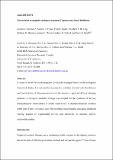Files in this item
Non-natural acetogenin analogues as potent Trypanosoma brucei inhibitors
Item metadata
| dc.contributor.author | Florence, Gordon J. | |
| dc.contributor.author | Fraser, Andrew L. | |
| dc.contributor.author | Gould, Eoin R. | |
| dc.contributor.author | King, Elizabeth F. B. | |
| dc.contributor.author | Menzies, Stefanie K. | |
| dc.contributor.author | Morris, Joanne C. | |
| dc.contributor.author | Tulloch, Lindsay B. | |
| dc.contributor.author | Smith, Terry K. | |
| dc.date.accessioned | 2015-08-20T23:10:49Z | |
| dc.date.available | 2015-08-20T23:10:49Z | |
| dc.date.issued | 2014-11 | |
| dc.identifier | 136135905 | |
| dc.identifier | eaeca0a2-3b2b-4d0f-8350-394d34b0bdc4 | |
| dc.identifier | 000344469500015 | |
| dc.identifier | 84927128266 | |
| dc.identifier | 000344469500015 | |
| dc.identifier.citation | Florence , G J , Fraser , A L , Gould , E R , King , E F B , Menzies , S K , Morris , J C , Tulloch , L B & Smith , T K 2014 , ' Non-natural acetogenin analogues as potent Trypanosoma brucei inhibitors ' , ChemMedChem , vol. 9 , no. 11 , pp. 2548-2556 . https://doi.org/10.1002/cmdc.201402272 | en |
| dc.identifier.issn | 1860-7179 | |
| dc.identifier.other | ORCID: /0000-0002-8987-5561/work/27750841 | |
| dc.identifier.other | ORCID: /0000-0001-7223-5106/work/42522374 | |
| dc.identifier.other | ORCID: /0000-0001-9921-4399/work/56638891 | |
| dc.identifier.uri | https://hdl.handle.net/10023/7289 | |
| dc.description.abstract | Neglected tropical diseases remain a serious global health concern. Here, a series of novel bis-tetrahydropyran 1,4-triazole analogues based on the framework of chamuvarinin, a polyketide natural product isolated from the annonaceae plant species are detailed. The analogues synthesized display low micromolar trypanocidal activities towards both bloodstream and insect forms of Trypanosoma brucei, the causative agent of African sleeping sickness, also known as Human African Trypanosomiasis (HAT). A divergent synthetic strategy was adopted for the synthesis of the key tetrahydropyran intermediates to enable rapid access to diastereochemical variation either side of the 1,4-triazole core. The resulting diastereomeric analogues displayed varying degrees of trypanocidal activity and selectivity in structure–activity relationship studies. Together, the biological potency and calculated lipophilicity values indicate that while there is room for improvement, these derivatives may represent a promising novel class of anti-HAT agents. | |
| dc.format.extent | 9 | |
| dc.format.extent | 2442040 | |
| dc.language.iso | eng | |
| dc.relation.ispartof | ChemMedChem | en |
| dc.subject | Acetogenin | en |
| dc.subject | Neglected diseases | en |
| dc.subject | HAT | en |
| dc.subject | T. brucei | en |
| dc.subject | Stereochemistry | en |
| dc.subject | Human African Trypanosomiasis (HAT) | en |
| dc.subject | Natural product analogues | en |
| dc.subject | Trypanosoma brucei | en |
| dc.subject | QD Chemistry | en |
| dc.subject | SDG 3 - Good Health and Well-being | en |
| dc.subject.lcc | QD | en |
| dc.title | Non-natural acetogenin analogues as potent Trypanosoma brucei inhibitors | en |
| dc.type | Journal article | en |
| dc.contributor.sponsor | The Leverhulme Trust | en |
| dc.contributor.sponsor | The Royal Society | en |
| dc.contributor.institution | University of St Andrews. School of Chemistry | en |
| dc.contributor.institution | University of St Andrews. Biomedical Sciences Research Complex | en |
| dc.contributor.institution | University of St Andrews. EaSTCHEM | en |
| dc.contributor.institution | University of St Andrews. School of Biology | en |
| dc.identifier.doi | https://doi.org/10.1002/cmdc.201402272 | |
| dc.description.status | Peer reviewed | en |
| dc.date.embargoedUntil | 2015-08-21 | |
| dc.identifier.grantnumber | RL-2012-025 | en |
| dc.identifier.grantnumber | UF090005 | en |
This item appears in the following Collection(s)
Items in the St Andrews Research Repository are protected by copyright, with all rights reserved, unless otherwise indicated.

